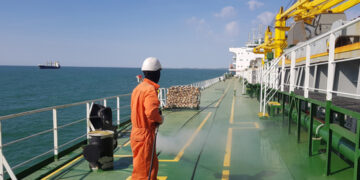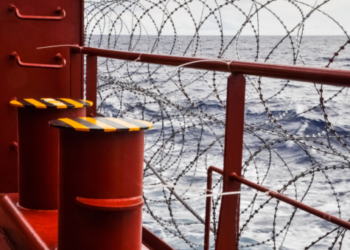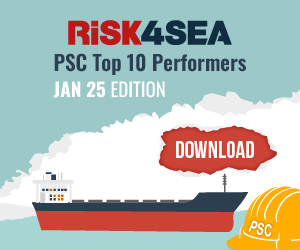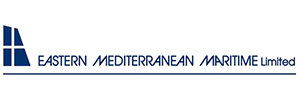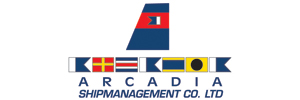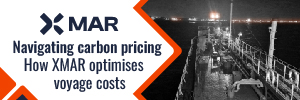The Atlantic Council has delved into the critical importance of the Suez Canal as a vital artery of global trade in order to point out the need for enhanced security measures to ensure the waterway’s smooth operation.
As explained, Given its strategic role as the fastest sea route between Asia and Europe, any disruption to the Suez Canal can have outsized impacts on global commerce and energy markets, which have occurred in recent years. Minimizing such disruption is an international concern. The Suez Canal is both a maritime choke point and a vital waterway for global trade and energy security. The 193-kilometer canal connecting the Red Sea and the Mediterranean:
- Attracts about 12 percent to 15 percent of worldwide trade and about 30 percent of global container traffic—with more than $1 trillion in goods transiting annually.
- Includes roughly 9 percent of global seaborne oil flows (about 9.2 million barrels per day in early 2023) and around 8 percent of liquefied natural gas (LNG) volumes.
- Averages fifty to sixty ships transiting the canal daily, carrying an estimated $3 billion to $9 billion in cargo value.
- Generates toll revenue—a major economic lifeline for Egypt—with a record of $9.4 billion set in 2022–2023.
It requires diplomacy and collaboration to bolster Suez area security and capacity building to protect trade flows and supply chains, reduce shipping and insurance costs, and foster a stable supply of energy.
The extended economic impact of incidents in the Suez Canal
| Event | Period | Key Economic Impacts |
|---|---|---|
| Suez Crisis | 1956-1957 |
|
| Arab-Israeli wars | 1967–1975 |
|
| Iran-Iraq War | 1980–1988 |
|
| Somali piracy | 2005–2012 |
|
| Ever Given blockage | 2021 |
|
Impact on global trade and economy
Conclusion and outlook
Ensuring canal security
The recent disruptions underscore that the Suez Canal’s strategic vulnerability is an international concern. Stability in the waterways connecting to the canal (e.g., the Red Sea, Bab el-Mandeb, and the Eastern Mediterranean) is critical for uninterrupted commerce.
A key policy lesson is the importance of proactive security and diplomatic measures to protect this choke point. Egypt already maintains a robust military presence to secure the canal itself, but the Red Sea attacks revealed the need for a broader cooperative security framework—potentially involving regional states and global naval powers—to ensure safe passage in surrounding seas. Going forward, multinational maritime patrols or convoy arrangements in the Red Sea could be considered during periods of high risk (such as past anti-piracy operations or the tanker convoys in the Persian Gulf during the 1980s).
Enhanced intelligence sharing and early-warning systems could help merchant fleets avoid danger. Diplomatically, addressing the root conflicts is paramount: a temporary ceasefire in the Israel-Palestine arena helped directly reduce attacks on shipping. International mediation in Yemen and dialogues with Iran are likewise crucial to prevent future flare-ups that threaten Suez traffic. Policy coordination, whether through the United Nations International Maritime Organization (IMO) or coalitions of concerned nations, will be needed to bolster the security of global shipping lanes in this region.
Treaties and agreements, such as the UN Convention on the Law of the Sea (UNCLOS), provide a legal foundation for international collaboration in maritime security efforts. By adhering to these frameworks, countries can formulate joint strategies, share best practices, and coordinate response mechanisms to maritime insecurity.
Examples of key collaborative maritime security initiatives
| Initiative | Description |
|---|---|
| Combined Maritime Forces (CMF) | Founded in 2001, the CMF is a multinational naval partnership aimed at promoting maritime security in the Gulf of Aden, the Arabian Sea, and the wider Indian Ocean region. Comprising more than thirty member nations, the CMF conducts operations to deter piracy, protect shipping lanes, and ensure maritime trade security. This collaborative approach has significantly reduced piracy incidents off the coast of Somalia, illustrating the effectiveness of pooled naval capabilities. |
| Operation Atalanta | The European Union launched Operation Atalanta in 2008 to combat piracy in the waters off the Horn of Africa. This mission involves deploying naval vessels from multiple European nations to protect shipping lanes, provide humanitarian aid, and support capacity-building efforts in regional maritime forces. By working collaboratively, participating countries have been able to enhance the security of vessels transiting high-risk areas, thus restoring confidence in maritime operations. |
| Djibouti Code of Conduct | This regional agreement, initiated under the auspices of the IMO, aims to enhance cooperation among countries in the western Indian Ocean to combat piracy and armed robbery at sea. It encourages information sharing, capacity building, and collaboration in addressing security threats, effectively fostering a cooperative approach among countries to safeguard maritime trade in the region. |
Other maritime routes are emerging, but they remain insufficient. Climate change is gradually opening the Northern Sea Route (NSR) along the Russian Arctic, which raises the prospect of an Asia-Europe sea route that circumvents the Suez Canal. However, Arctic routes are not yet commercially viable for mainstream shipping: seasonal ice, specialized vessel needs, and a lack of infrastructure pose significant challenges. In the foreseeable future, the NSR will remain a limited-use route for specific ships and seasons, rather than a full alternative to the Suez Canal.
Meanwhile, the Cape of Good Hope route will continue to be the primary backup when the Suez is impassable, despite its longer distance. This reality was underscored during the Red Sea crisis. When faced with danger, the shipping industry’s only immediate large-scale alternative was essentially to go around Africa. While effective as a stopgap, that solution carries significant economic, logistical, and environmental costs, reinforcing why maintaining the Suez’s accessibility is so crucial.
Strengthening the canal’s infrastructure resilience
There is a policy impetus to build infrastructure resilience into existing trade corridors. The Suez Canal itself has undergone upgrades: For example, the 2015 expansion created a second channel section to allow two-way traffic and reduce transit time. Further investments by Egypt aim to increase the canal’s capacity and enable it to handle even larger vessels. Additionally, ports and logistics hubs on alternative routes are being enhanced to handle diverted traffic during emergencies. Such investments, often with support from development banks, seek to alleviate bottlenecks when trade shifts unexpectedly due to conflict or crisis.
Investment in technological solutions, training, and capacity building
International cooperation in maritime security can also extend to technological advancements. Countries can work together to develop and deploy surveillance systems, maritime domain-awareness tools, and advanced communication networks to monitor shipping activities effectively. For example, the Automatic Identification System (AIS) allows vessels to broadcast their location in real time, helping authorities to track maritime traffic and respond to security threats proactively. Joint investments in such technologies can enhance situational awareness and risk assessment, ensuring swift and effective responses to potential emergencies.
Investment in international training programs for naval forces and coast guards can further bolster maritime security. Collaborative efforts such as joint exercises, workshops, and exchange programs can equip personnel with the skills and knowledge needed to respond effectively to maritime challenges. For instance, the US Navy’s Partnership for Peace Program promotes military-to-military cooperation and training among countries, enhancing their ability to manage maritime responsibilities and contingencies. This collaborative effort can be further developed.
Policymakers and industry leaders will need to collaboratively safeguard the Suez Canal’s continuity, through security cooperation and contingency planning, to ensure that geopolitical conflicts do not again choke off one of the world’s most important trade arteries. The recent disruptions serve as a call to action to reinforce the resilience of global supply chains against such shocks.







